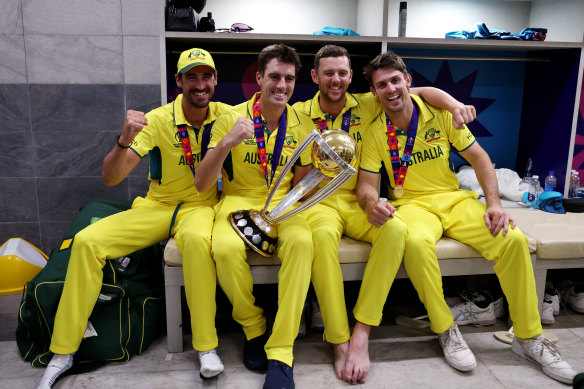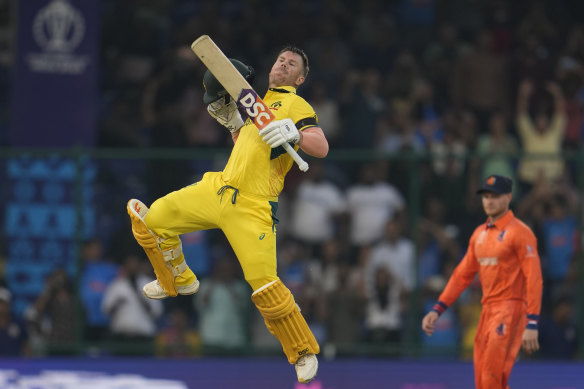Save articles for later
Add articles to your saved list and come back to them any time.
It began with a catch. Not Travis Head’s screamer to swing the momentum in Sunday night’s final by removing the rampant Indian captain Rohit Sharma, but the one David Warner took last month, which now seems way back in the mists of time.
Australia were anchored to the bottom of the table after early losses to India and South Africa. They had the worst catching record in this World Cup and Sri Lanka, also winless, were 0-125. Sri Lanka had made 300 in their first two games, whereas a hapless Australia hadn’t managed even 200.
Desperate for a wicket to spark his listless side, captain Pat Cummins bowled short again at Sri Lankan opener Pathum Nissanka, who was 61 from 67 balls. The right-hander hooked but failed to time the bouncer cleanly and from deep square leg David Warner charged to his left, dived and slid to claim a stunning catch.
It was the moment when Australia’s World Cup campaigned shifted from embarrassing to enterprising. There was many a time after that the Australians failed to play pretty cricket, but from then on they scrapped and bashed and fought their way to and through a semi-final before going on to claim the ultimate prize.
This is how they did it.
Leadership
Pat Cummins has put to bed any lingering doubts about his ability to handle the captaincy while also being Australia’s premier fast bowler. Cummins saved his best till last with brave and decisive captaincy combined with ever improving personal performances.
His decision to bowl against an unbeaten, and seemingly impregnable, India when they had dominated the competition batting first proved a stroke of genius. India succumbed to the pressure as Cummins played a central role with the ball, claiming the important wickets of the explosive Shreyas Iyer and Virat Kohli while conceding just 34 runs from his 10 overs.
Mitchell Starc, Pat Cummins, Josh Hazlewood and Mitch Marsh of Australia pose with the World Cup trophy.Credit: Getty
Going into the tournament, Cummins and his team were cooked after their mid-year Ashes tour of England. Having jumped out of the blocks in June with an inaugural World Test Championship victory over India at The Oval and then gone 2-0 up in the Ashes, Australia faded badly without the support of injured spinner Nathan Lyon, drawing the series 2-2 – which was still good enough for them to retain the urn.
Questions were being asked about whether Australia were roasting their golden goose by lumping too much on Cummins’ plate. For his part, he remained as phlegmatic as ever, saying he was comfortable in the role. The questions, however, continued as a lethargic Australia were thumped in their opening two matches World Cup matches against India and South Africa.
But despite the background noise whenever the players talked about Cummins, the central theme was, and still is, his calmness – not a quality always associated with Australian teams. Dressing rooms can be crowded and uncomfortable places, occupied by people with strong egos and emotions. Calmness is a vital ingredient for sustained success.
Howzat for openers
David Warner has been Australia’s dancing panther. Whether it has been the bursts of ferocious stroke play at the crease, the dashing speed between the wickets or the relentless prowling of the boundary, Warner has been in everything – even when he hasn’t scored many runs. His fielding alongside Marnus Labuschagne in the low-scoring semi-final was other-worldly.
Warner missed out in the final, but the indefatigable left-hander has been Australia’s leading run-scorer for a second successive World Cup, with 535 runs at 49 and a strike rate of 108, one of the best in the tournament. Successive scores of 163 against Pakistan, 104 against the Netherlands and 81 against New Zealand help set Australia on course towards the semi-finals.
Add to that his Bollywood dance moves when the music was blaring between overs that set the home crowd alight and Warner has been impossible to keep out of the game.
David Warner celebrates a century against the Netherlands.Credit: AP
His man-of-the-match 163 against Pakistan came in an opening partnership of 259 with Mitchell Marsh (121 in 108), reinforcing one of the central tenants of success in one-day cricket, cashing in on the first 10-over power play when the ball is hard and the field is up.
But with the return of Travis Head from a broken wrist midway through the tournament, Warner became sideshow Dave. Head announced his return with 109 from 67 balls against New Zealand, the first of three man-of-the-match awards, including in the semi-final and final.
Of the eight centuries scored by Australians, five were scored by openers, two by Warner, two by Head, and one by Marsh, who also made a second century batting at No.3 against Bangladesh.
The coach and selectors
Rarely can a team’s backroom staff have had such a big impact on a World Cup campaign as coach Andrew McDonald and chairman of selectors George Bailey, who was with the team the whole time.
Captain Cummins talks about how McDonald came to him the day after Travis Head sustained a broken wrist on a one-day tour of South Africa just two weeks out from the tournament. The coach hadn’t slept before deciding they would keep Head in the squad.
This had a significant knock-on impact. Marnus Labuschagne, who had been left out of Australia’s original 18-man preliminary squad, was sudden shoe-horned into the final 15-man squad after good form in South Africa, playing as a concussion sub for Cameron Green.
With Ashton Agar ruled out because of a calf strain, this meant Australia were substituting a batsman for a spinner, leaving Adam Zampa as the team’s only frontline spinner in the squad, in India of all places. Some commentators called this brave, others fool hardly.
The spinner
Like Travis Head, Zampa repaid the faith of the selectors in spades. Struggling with shoulder and neck problems and feeling ill, Zampa was pivotal in Australia’s first victory of the campaign, claiming 4-47 to be player of the match as Sri Lanka collapsed from 0-125 to be all out 209.
Zampa went on to claim four wickets in three consecutive games and became the first player in World Cup history to take three wickets or more in five consecutive games.
He was also player of the match against England with 3-21 and went on to equal the record of 23 wickets for a spinner in a World Cup set by Sri Lanka’s Muttiah Muralitharan in 2007.
The magician
Glenn Maxwell does things other cricketers can’t. Sometimes his shots look terrible, the cheap sacrificing of a wicket. Other times they’re astonishing. In this World Cup he created history, twice.
The first came again the Netherlands when he cracked the fastest World Cup century in history, off just 40 balls. The second was a dramatic epic against Afghanistan which featured Maxwell lying on the ground in agony at one stage with full-body cramps.
It was as if he had hired Shane Warne’s scriptwriter, standing rooted to the spot for fear that more movement would elicit another bout of cramps. With one final blow into the stands Maxwell created a triple miracle, bringing up his double century, victory, and a place in the semi-finals. Australia had been 7-91 at one stage, needing another 200 for victory.
But an equally important and much underrated part of his game was Maxwell’s off-spin as Australia’s de facto second spinner. He bowled 68.3 overs to be Australia’s genuine fifth bowler, conceding under five runs an over, equal with Josh Hazlewood as the best in the team.
And he deceived rampant Indian captain Rohit Sharma in the final to have him brilliantly caught by Head, changing the course of the game.
In conclusion …
If there is one word that sums up Australia’s campaign it is brave. Brave at the selection table, brave captaincy by Cummins after two losses, and brave batting to keep taking the game on. This World Cup triumph was a win for the ages.
Sports news, results and expert commentary. Sign up for our Sport newsletter.
Most Viewed in Sport
From our partners
Source: Read Full Article


